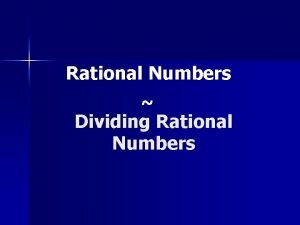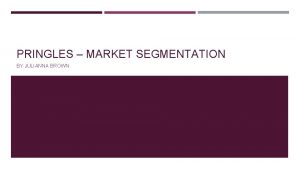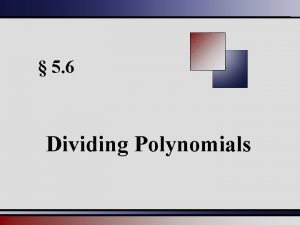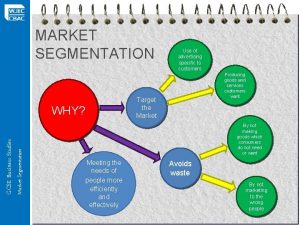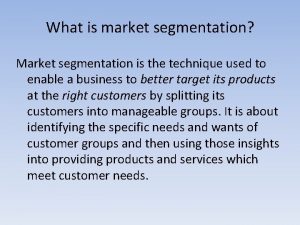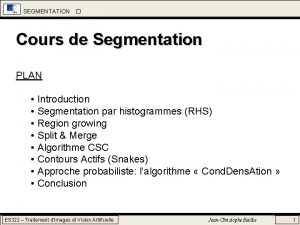Market Segmentation The process of dividing a potential








































- Slides: 40

Market Segmentation The process of dividing a potential market into distinct subsets of consumers and selecting one or more segments as a target market to be reached with a distinct marketing mix.

Why Segment? Market segmentation More precise definition of customers needs and wants More accurate marketing objectives Improved resource allocation Better marketing results

Market Segments

Market Segmentation The process of dividing a potential market into distinct subsets of consumers and selecting one or more segments as a target market to be reached with a distinct marketing mix.

Market Segmentation Market People or organizations with needs or wants and the ability and willingness to buy Market Segment A subgroup of people or organizations sharing one or more characteristics that cause them to have similar product needs. Market Segmentation The process of dividing a market into meaningful, relatively similar, identifiable segments or groups.

Indian car market Segmentation

creaminess sweetness Homogeneous Preference -no natural segments -all buyers have same preference

creaminess sweetness Diffused Preference -no pattern (…or poor research) -take center position

creaminess sweetness Clustered Preference -natural segments -increases as number of competitors increases

Criteria for Segmentation Substantiality Segment must be large enough to warrant a special marketing mix. Identifiability Measurability Segments must be identifiable and their size measurable. Accessibility Members of targeted segments must be reachable with marketing mix. Responsiveness Unless segment responds to a marketing mix differently, no separate treatment is needed.

Consumer Markets STATE OF BEING Geographic STATE OF MIND Demographic Psychographic Behavioral

Geographic Segmentation The division of a total potential market into smaller subgroups on the basis of geographic variables (e. g. , region, state, or city).

Geographic Variables Region City or metro size Pacific, Mountain, West North Central, West South Central, East North Central, East South Central, South Atlantic, Middle Atlantic, New England Under 4, 999; 5, 000 -19, 999; 20, 000 -49, 999. . . 1, 000 -3, 999; 4, 000 and over Density Urban, rural, suburban Climate Northern, southern

Demographic Variables Age Gender Occupation Family size Education Nationality Religion Income Ethnicity

Marital Status n Households as a consuming unit q q Singles Divorced Single parents Dual-income married

Sociocultural Segmentation n Family Life Cycle Social Class Culture, Subculture, and Cross-Culture

Family Life Cycle n Phases a family goes through in their formation, growth, and final dissolution q q q n n Bachelorhood Honeymooners Parenthood Post-parenthood Dissolution Explicit basis: marital status, family status Implicit basis: age, income, employment

Psychographic Variables Lifestyle Hobbies TV viewing habits Social activities Club memberships Vacation preferences Personality Compulsive Outgoing Authoritarian Ambitious

Behavioral Variables Occasions Regular occasion, special occasion Benefits Quality, service, economy, speed User status Nonuser, ex-user, potential, first-time, regular Usage rate Light user, medium user, heavy user Loyalty status None, medium, strong, absolute Readiness stage Unaware, informed, interested, intends to buy Enthusiastic, positive, indifferent, negative, hostile Attitude toward product

THE TOOTHPASTE MARKET The package of benefits sought n n n n WHITENESS FRESHNESS GOOD TASTING PRODUCT APPEARANCE DECAY PREVENTION GUMS PROTECTION TEETH SENSITIVITY ECONOMY

Use-Related Segmentation n Rate of Usage q n Awareness Status q n Heavy vs. Light Aware vs. Unaware Brand Loyalty q Brand Loyal vs. Brand Switchers

Usage-Situation Segmentation n n Segmenting on the basis of special occasions or situations Example Statements: q q q Whenever our daughter, Jamie, gets a raise, we always take her out to dinner. When I’m away on business, I try to stay at a suites hotel. I always buy my wife flowers on Valentine’s Day.

Market Segmentation The bicycle-riders productmarket Submarket 1 (Exercisers) Submarket 2 (Off-road adventurers) 3 -8 Submarket 3 (Transportation riders) Submarket 4 (Socializers) Submarket 5 (Environmentalists)

Generic vs Product Market

Narrowing Down to Target Markets

Market Segmentation SEGMENTATION BASE SELECTED SEGMENTATION VARIABLES Geographic Segmentation Region Southwest, Mountain States, Alaska, Hawaii City Size Major metropolitan areas, small cities, towns Density of area Urban, suburban, exurban, rural Climate Temperate, hot, humid, rainy Demographic Segmentation Age Under 11, 12 -17, 18 -34, 35 -49, 50 -64, 65 -74, 75 -99, 100+ Sex Male, female Marital status Single, married, divorced, living together, widowed Income Under $25, 000, $25, 000 -$34, 999, $35, 000 -$49, 999, $50, 000 -$74, 999, $75, 000 -$99, 999, $100, 000 and over Education Some high school, high school graduate, some college, college graduate, postgraduate Occupation Professional, blue-collar, white-collar, agricultural, military

continued SEGMENTATION BASE SELECTED SEGMENTATION VARIABLES Psychological Segmentation Needs-motivation Shelter, safety, security, affection, sense of self-worth Personality Extroverts, novelty seeker, aggressives, low dogmatics Perception Low-risk, moderate-risk, high-risk Learning-involvement Low-involvement, high-involvement Attitudes Positive attitude, negative attitude Psychographic (Lifestyle) Segmentation Economy-minded, outdoors enthusiasts, status seekers Sociocultural Segmentation Cultures Religion Subcultures (Race/ethnic) Social class Family life cycle American, Italian, Chinese, Mexican, French, Pakistani Catholic, Protestant, Jewish, Moslem, other African-American, Caucasian, Asian, Hispanic Lower, middle, upper Bachelors, young married, full nesters, empty nesters

SEGMENTATION BASE Use-Related Segmentation Usage rate Awareness status Brand loyalty Use-Situation Segmentation Time Objective Location Person Benefit Segmentation Hybrid Segmentation Demographic/ Psychographics Geodemographics SRI VALSTM SELECTED SEGMENTATION VARIABLES Heavy users, medium users, light users, non users Unaware, interested, enthusiastic None, some, strong Leisure, work, rush, morning, night Personal, gift, snack, fun, achievement Home, work, friend’s home, in-store Self, family members, friends, boss, peers Convenience, social acceptance, long lasting, economy, value-for-the-money Combination of demographic and psychographic profiles of consumer segments profiles “Money and Brains, ” “Black Enterprise, ” “Old Yankee Rows, ” “Downtown Dixie-Style” Actualizer, fulfilled, believer, achiever, striver, experiencer, maker, struggler

Steps in Segmentation, Targeting, and Positioning 6. Develop Marketing Mix for Each Target Segment 5. Develop Positioning for Each Target Segment 4. Select Target Segment(s) 3. Develop Selection Criteria 2. Develop Profiles of Resulting Segments 1. Identify Bases for Segmenting the Market Positioning Market Targeting Market Segmentation

Step 2. Market Targeting Evaluating Market Segments (developing selection criteria) • Segment Size and Growth – Analyze sales, growth rates and expected profitability for various segments. • Segment Structural Attractiveness – Consider effects of: Competitors, Availability of Substitute Products and, the Power of Buyers & Suppliers. • Company Objectives and Resources – Company skills & resources relative to the segment(s). – Look for Competitive Advantages.

Step 2. Market Targeting Market Coverage Strategies Company Marketing Mix Market A. Undifferentiated Marketing Company Marketing Mix 1 Company Marketing Mix 2 Company Marketing Mix 3 Segment 1 Segment 2 Segment 3 B. Differentiated Marketing Company Marketing Mix Segment 1 Segment 2 Segment 3 C. Concentrated Marketing

Step 2. Market Targeting Choosing a Market-Coverage Strategy Company Resources Product Variability Product’s Life-Cycle Stage Market Variability Competitors’ Marketing Strategies

Linking the Concepts • At the last ‘linking the concepts’, you segmented the Irish clothing market. > Now, pick two companies that serve this market and describe their segmentation and targeting strategies. > Can you come up with one that targets many different segments versus another that focuses on only one or a few segments? • How does each company you choose differentiate its marketing offer and image? • How has each done a good job of establishing this differentiation in the minds of targeted consumers?

Step 3. Positioning for Competitive Advantage • Product’s Position - the way the product is defined by consumers on important attributes - the place the product occupies in consumers’ minds relative to competing products. • Marketers must: – Plan positions to give their products the greatest advantage in selected target markets, – Design marketing mixes to create these planned positions.

Step 3. Positioning for Competitive Advantage: Strategies Product Class Product Attributes Away from Competitors Benefits Offered G H C A Against a Competitor D E B User Class F Usage Occasions

Steps to Choosing and Implementing a Positioning Strategy • Step 1. Identifying Possible Competitive Advantages: Competitive Differentiation. • Step 2. Selecting the Right Competitive Advantage: Unique Selling Proposition (USP). • Step 3. Communicating and Delivering the Chosen Position. • Step 4. Support the positioning strategy with a unique marketing mix

Developing Competitive Differentiation Product Service Areas for Competitive Differentiation Image People

Selecting the Right Competitive Advantages Important Profitable Affordable Preemptive Criteria for Determining Which Differences to Promote Distinctive Superior Communicable

Step 4 – Supporting the positioning strategy • At this stage the company has decided on its positioning strategy and must now design a marketing mix to support this strategy. The next part of the course looks at ‘Developing the Marketing Mix’

Reviewing the Concepts • Define three steps of target marketing: market segmentation, market targeting, and market positioning. • List and discuss the major levels of market segmentation and bases for segmenting consumer and business markets. • Explain how companies identify attractive market segments and choose a market coverage strategy. • Discuss how companies position their products for maximum competitive advantage in the marketplace.
 Market segmentation is the process of dividing
Market segmentation is the process of dividing Mindbase segments
Mindbase segments International market segmentation
International market segmentation Dividing rational numbers worksheet
Dividing rational numbers worksheet Market potential and forecasting
Market potential and forecasting Process of market segmentation
Process of market segmentation Market segmentation slideshare
Market segmentation slideshare Market leader challenger follower nicher examples
Market leader challenger follower nicher examples Osmotic potential vs water potential
Osmotic potential vs water potential Water potential equation
Water potential equation ψs
ψs Graded potential vs action potential
Graded potential vs action potential Graded potential and action potential
Graded potential and action potential Graded potential
Graded potential Difference between action and graded potential
Difference between action and graded potential Graded potential
Graded potential Osmotic potential vs water potential
Osmotic potential vs water potential Sources of bioelectric potentials
Sources of bioelectric potentials Hypopolarization
Hypopolarization Neuromuscular junction
Neuromuscular junction Action potential resting potential
Action potential resting potential Action potential resting potential
Action potential resting potential Define electric potential and potential difference.
Define electric potential and potential difference. Electric potential energy
Electric potential energy Electric potential
Electric potential Electric potential and potential difference
Electric potential and potential difference Potential energy of an electric field
Potential energy of an electric field Pe=-qed
Pe=-qed What is electrical potential
What is electrical potential Geographic segmentation of cadbury
Geographic segmentation of cadbury Market segmentation analysis template
Market segmentation analysis template Market segmentation and targeting ppt
Market segmentation and targeting ppt Bssu
Bssu Nivea positioning statement
Nivea positioning statement Requisites of sound marketing segmentation
Requisites of sound marketing segmentation Pringles brand positioning
Pringles brand positioning Bases of market segmentation
Bases of market segmentation Health insurance market segmentation
Health insurance market segmentation Demographic geographic psychographic market segmentation
Demographic geographic psychographic market segmentation Market segmentation matrix
Market segmentation matrix Brand positioning statement of nike
Brand positioning statement of nike



